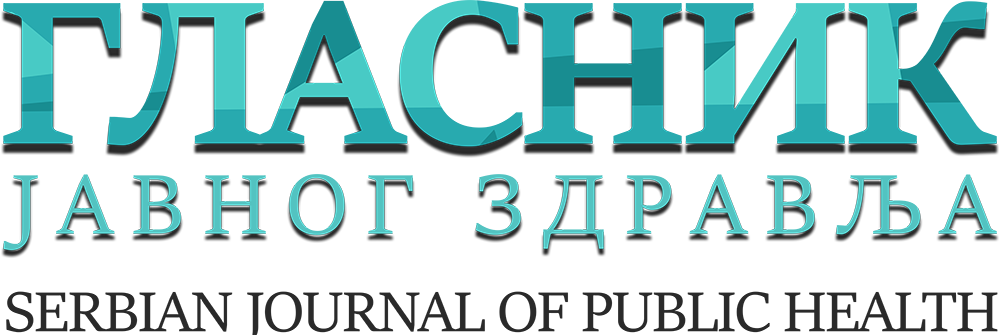

Архива






The Serbian Journal of Public Health is a multidisciplinary journal with peer review, publishing articles from all fields related to public health, in Serbian and in English. It is published by the Institute of Public Health of Serbia „Dr Milan Jovanović Batut“ four times per year, in hard-copy and digital form. The Journal publishes the following types of articles: original scientific papers, reviews, preliminary and summary statements, case reports, reports from scientific meetings and congresses, editorials and letter to the editor and other articles.
The first issue of the Journal of the Central Hygiene Institute was published in 1926 in Belgrade. Journal was published continuously until 1941, four times per year. After an 11-year break, the journal was re-established in 1952 and issued until 1974, when another twenty-year break ensued. The last issue of the Journal came out in 2008. Throughout its long history, the Journal was issued under several names, depending on the name of the central public health institution in Serbia. However journal’s mission remained the same, to improve research, policies, practice and education in the field of public health.
Editor-in-chief of the Journal of Public Health, in consultation with the members of the Editorial Board and in line with the results of the peer review, makes the final decision on which manuscripts will be published. In making that decision, the Editor-in-chief, deputy and assistant editors, as well as the members of the Editorial Board, are be governed by editorial policy, bearing in mind legislation regulating slander, copyright infringement and plagiarism. Secretary of the Editorial Board notifies the Editorial Board on each received article, while the Editor-in-chief reserves the right not to publish some of the received manuscripts should they be found not to meet the prescribed criteria for content and form. The Editor-in-chief and the members of the Editorial Board are obliged to judge the manuscript based on its content, with no racial, gender, religious, ethnic, political or any other prejudice. Editor-in-chief must have no conflict of interest with regards to any manuscript under consideration. In case such a conflict of interest exists, the deputy and assistants to the Editor-in-chief will decide on the selection of reviewers and other issues related to such a manuscript. In addition, if there is a conflict of interest for one or more members of the Editorial Board, such members are excluded from the procedure of reviewer selection and the decision-making process regarding the manuscript. Editor(s) and members of the Editorial Board are obliged to report conflicts of interest in a timely manner. Editor(s) and members of the Editorial Board must not use unpublished material from the submitted manuscripts for their own research, without explicit written permission of the author; ideas and information presented in the submitted manuscripts must be kept confidential and must not be used for private gain or for any other purpose.
Editor(s) and members of the Editorial Board are obliged to undertake measures to keep the identity of reviewers from the authors prior to, during and after the review process, and to keep the identity of the authors from the reviewers until the end of the review process.
Authors will guarantee that their papers have not been published before, i.e., the articles must not be submitted, at the same time, to another journal for publishing. Authors also guarantee that, after its publication in the Journal of Public Health, the manuscript will not be published in another publication, in any language, without the consent of the publisher. If the paper in question is a part of a doctoral thesis or a research project, or had previously been published in proceedings as an abstract, this fact will be stated in a separate note at the end of the text.
Content – the paper should contain sufficient details and references to allow first the reviewers, and subsequently the readers, to check the claims made therein. Authors guarantee that the manuscript contains no unfounded or illegal claims and does not violate the rights of any third party. The publisher shall not be liable for any claims for damages. Authors who wish to include illustrations, tables or other materials that have already been published are obliged to provide accurate information about the source from which such materials had been reproduced. If there is no such information, the submitted material will be considered original work of the author. If, at any subsequent stage, any kind of dispute arises (e.g., objections of copyright holders that certain materials have been published without their consent), the Journal will print a correction, or distance itself from the paper in a special note, clearly stating that the author of the paper is responsible for the error, while the article shall be retracted in line with a predefined procedure.
Authorship – Authors are obliged to list, as authors, only those persons who contributed significantly to the content of the manuscript. If other persons, who are not authors, participated in important aspects of the research project and manuscript preparation, their contribution should be clearly stated in a note, or an acknowledgment.
References – Authors are obliged to correctly reference sources used in the development of the manuscript.
Plagiarism – Plagiarism, or appropriation of another party’s ideas, words or other forms of creative expression and their representation as one’s own, represents a severe violation of scientific and publishing ethics. Plagiarism may include copyright infringement, which is punishable by law.
Plagiarism includes:
Each submitted manuscript shall be checked using appropriate plagiarism detection software.
Manuscripts with clear indications of plagiarism will automatically be rejected, and authors will be permanently or temporarily banned from publishing articles in the Journal.
If it is found that an article published in the Journal is plagiarized, the article will be retracted in line with the Retraction procedure described below, and authors will be permanently or temporarily banned from publishing in the Journal.
Conflict of interest – Authors are obliged to note any financial or other conflicts of interest that could affect their findings and interpretations.
Errors in published articles – If authors discover a significant error in their article after its publication, they are obliged to inform the Editor-in-chief and the Journal’s Editorial College and cooperate with them to retract or correct the article.
Open access policy
The Journal of Public Health is an open access journal. All articles can be downloaded free of charge. The Journal collects no fees in any stage of submission, review or publication.
Reviewers are obliged to assess the article’s compliance with the Journal profile, relevance of the investigated topic and the methods used, originality and scientific relevance of the information presented in the manuscript, as well as the style of presenting scientific facts. They are obliged to provide thoughtful, objective, constructive and informative feedback on the manuscript, as well as the ways in which the manuscript can be improved. You can find detail on the reviewers’ obligations to authors and editors here.
The review process
Reviewer selection is of key importance for the manuscript review process, and the Editorial Board of the Journal will determine the criteria for reviewer selection. Reviewers must have relevant knowledge in the field covered in the manuscript. Selected reviewers make up the List of Reviewers maintained by the Journal’s Editorial College. List of Reviewers is published annually in the Journal. Reviews are voluntary.
All submitted manuscripts are subjected to the review process. The purpose of the review is to help the Editorial College of the Journal to make editorial decisions and to improve the quality of the manuscripts in communication with authors. The review process is “double blind” and anonymous. All reviewers will remain anonymous to authors, and authors anonymous to reviewers before, during and after the review process. In addition, reviewers work independently of each other, i.e., reviewers are not privy to the identity of other reviewers.
Before a manuscript is sent for review, potential reviewers are contacted and presented with the Abstract; only after they accept the review, the full manuscript is sent to them. The reviewer is required to confirm, by e-mail and within 3 days, the receipt of the manuscript and their willingness to complete the review within 3 weeks. Each reviewer is sent the Reviewer’s Instruction and Review Form, i.e., Review Report form, together with the manuscript. At least two reviews are requested for each manuscript. If the opinions of the reviewers are opposed, a third, independent opinion is requested. In addition, in case of any doubt of the objectivity or quality of reviews, the Editorial College of the Journal shall provide additional reviewers, as quality assurance for the review process.
Any individual or institution may, at any point in time, report to the Editor and/or Editorial College any knowledge of violations of ethical standards and other irregularities, and provide the supporting information or evidence. Editor-in-chief will decide on initiating the procedure to verify the submitted allegations and evidence, in agreement with the members of the Editorial Board. During such a procedure, all evidence presented will be considered confidential and disclosed only to the persons directly involved in the procedure. If irregularities are confirmed, it will be assessed whether they should be characterized as a minor offense or as a severe violation of ethical standards.
Minor offense
Situations described as a minor offenses will be resolved in direct communication with persons who have committed the offense, without third party involvement, e.g.:
Severe violation of ethical standards
Decisions related to severe violations of ethical standards are made by the Editor-in-chief together with the members of the Editorial Board and the Editorial College, and, if necessary, a small group of experts. Measures to be undertaken may be the following (and may be applied individually or jointly):
In resolution of disputes, the Editorial College is steered by the guidelines and recommendations of the Committee on Publication Ethics (Committee on Publication Ethics – COPE).
Retraction procedure – In case of violation of the rights of publishers, copyright holders or authors, breach of professional code of ethics, i.e., in the case of submission of an article to several journals at the same time, false claims of authorship, plagiarism, manipulation of data for fraudulent purposes, as well as in all other cases of severe violation of ethical standards, the published article must be retracted. In some cases, articles may also be retracted to correct errors that have been found after publication.
Standards for resolution of situations leading to retraction are defined by libraries and scientific bodies, and the Journal has adopted the same practice: in the digital version of the original article being retracted, an HTML link is placed in the article with the retraction notice. The retracted article is preserved in its original form, but with a PDF watermark indicating that it has been retracted (RETRACTED) on each page.
Once a manuscript is accepted for publication, authors transfer their copyright to the publisher. In case a manuscript is not accepted for publication, authors reserve all rights.
The following rights, related to the manuscript (including all additional materials, as well as all parts, excerpts or elements of the manuscript), are transferred to the publisher:
Right to make the manuscript available to the public or to closed groups of users based on individual requests, for use on monitors and other readers (including e-book readers), as well as in hard copy, through the Internet, on-line, or via internal or external networks.
Articles published in the Journal are subject to the Open Access rules and may be distributed in line with the Creative Commons license.
Authors reserve the right to translate the article into another language, to use it in a compilation of their work, e.g., in their doctoral dissertation or monographs, both commercially and non-commercially, as long as they recognize where it was originally published. Full bibliographic information on the original publication (authors, title, Journal name, volume, issue, page number) must be included, as well as a DOI link to the article.
Positions presented in the published articles do not reflect the positions of the Editor or members of the Editorial College. Authors assume all legal and moral responsibility for the ideas presented in their articles. The publisher shall not be liable for any claims for damages.